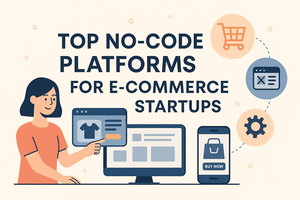Inventory Management Software for Retail Stores: A Complete Guide to Smarter Stock Control
In the fast-paced world of retail, managing inventory effectively can make or break a business. Whether you’re running a small boutique or a multi-location retail chain, having the right inventory management software is no longer a luxury—it’s a necessity.
From tracking stock levels in real time to streamlining supply chains and minimizing shrinkage, modern inventory systems are revolutionizing how retail stores operate.
This article explores everything you need to know about inventory management software for retail stores, including its benefits, features, and how to choose the right solution for your business.
Why Inventory Management is Critical for Retail Success
Inventory is the backbone of any retail operation. Without a clear, real-time picture of what’s in stock, what’s selling, and what needs to be reordered, retailers face serious issues such as:
-
Stockouts and lost sales
-
Overstocking and tied-up capital
-
Inefficient supply chain decisions
-
Wasted storage space
-
Unhappy customers due to delays or errors
Manual tracking using spreadsheets or paper records is not only outdated but highly error-prone. That’s where inventory management software comes in—automating critical tasks, providing data-driven insights, and giving business owners control over every product that enters and exits their store.
What Is Inventory Management Software?
Inventory management software is a digital tool that helps retailers monitor and control stock levels, manage purchase orders, track shipments, and optimize inventory turnover. Unlike basic point-of-sale systems, these platforms offer comprehensive features such as:
-
Barcode scanning and tagging
-
Real-time inventory updates
-
Sales analytics and forecasting
-
Multi-store synchronization
-
Automated low-stock alerts
-
Vendor and supplier management
-
Integration with POS, e-commerce, and accounting systems
This technology simplifies operations, reduces human error, and ensures that the right products are available at the right time.
Key Benefits of Using Inventory Management Software in Retail
The advantages of inventory management software extend well beyond convenience. Here’s how it empowers retailers:
1. Real-Time Stock Visibility
Retailers can access up-to-date stock levels at any time from any device. This allows staff to make accurate sales and restocking decisions, reducing guesswork and improving customer satisfaction.
2. Accurate Demand Forecasting
Using historical sales data and analytics, software can predict trends, helping retailers stock best-sellers in time for peak demand and avoid slow-moving items.
3. Loss Prevention and Shrinkage Control
Inventory software can track every item’s movement—reducing theft, spoilage, or misplacement. It allows for quicker identification of discrepancies and faster audits.
4. Improved Cash Flow
With better inventory control, retailers can avoid overbuying, freeing up capital for marketing, payroll, or business expansion.
5. Multi-Channel Integration
Today’s software solutions allow synchronization across physical stores, online platforms (like Shopify or WooCommerce), and warehouses—ensuring seamless operations across all sales channels.
6. Automated Alerts and Reordering
Set low-stock thresholds and reorder levels so the system automatically notifies managers or places purchase orders—preventing out-of-stock issues.
Must-Have Features in Retail Inventory Management Software
Choosing inventory software depends on the scale and nature of your business. However, the following features are essential for modern retail operations:
-
Barcode and QR Code Scanning: For efficient stock tracking and faster checkout.
-
Multi-Location Inventory Tracking: Ideal for businesses with more than one outlet or warehouse.
-
Customizable Reports and Dashboards: Offers insights into top-selling items, slow movers, profit margins, etc.
-
Purchase Order Management: Create and manage POs directly within the system.
-
Mobile Accessibility: Lets users check and update inventory from smartphones or tablets.
-
Integration with Accounting Software: Syncs with tools like QuickBooks, Xero, or Zoho Books for smoother financial tracking.
-
Return and Refund Management: Tracks returns to maintain accurate inventory records.
Top Inventory Management Software for Retail Stores in 2025
The software landscape is filled with great options tailored for retail businesses of all sizes. Some leading platforms include:
1. Lightspeed Retail
A cloud-based POS and inventory solution ideal for multi-store retailers. It offers robust inventory control, purchase orders, and supplier management.
2. Square for Retail
Known for its simple interface and affordability, Square includes inventory tracking, sales analytics, and barcode scanning in one solution.
3. Zoho Inventory
Great for retailers looking for an end-to-end solution with e-commerce and CRM integration. It supports automation, multi-warehouse tracking, and dropshipping.
4. Cin7
Offers advanced inventory features including real-time tracking, forecasting, and integrations with Shopify, Amazon, and accounting software.
5. Vend (by Lightspeed)
This is another powerful retail POS with solid inventory features, ideal for small to mid-sized retailers. It syncs seamlessly with e-commerce platforms and has offline functionality.
How to Choose the Right Inventory Software for Your Retail Business
Before you commit to a solution, assess your store’s specific needs. Ask yourself:
-
Do I need integration with my POS or e-commerce store?
-
How many locations or warehouses do I operate?
-
What’s my budget for monthly software subscriptions?
-
Do I need mobile access or offline capability?
-
How much customization do I require in reporting and dashboards?
It’s advisable to try free trials of 2–3 options before finalizing. Look for software that is scalable, reliable, and comes with responsive customer support.
Common Mistakes Retailers Make with Inventory Software (and How to Avoid Them)
Even with the best tools, mistakes can happen. Here are a few pitfalls to watch out for:
-
Ignoring Software Training: Ensure your staff is properly trained on the software to maximize its potential.
-
Not Updating Inventory in Real Time: Delays in logging sales or deliveries can lead to major discrepancies.
-
Overreliance on Automation: Technology is a tool, not a replacement for sound inventory planning.
-
Failing to Audit Regularly: Periodic physical inventory checks help validate system data and spot theft or loss.
-
Choosing Based on Price Alone: Cheap tools can be costly in the long run if they lack essential features.
Inventory Software and Customer Experience
At first glance, inventory management may seem like an internal process—but it has a direct impact on customer satisfaction. When your shelves are always stocked, delivery estimates are accurate, and order issues are handled smoothly, your reputation as a reliable brand grows. Happy customers mean repeat business, positive reviews, and referrals.
By investing in the right inventory software, you’re not just optimizing backend operations—you’re enhancing the entire shopping experience.
The Future of Inventory Management in Retail
As artificial intelligence and machine learning evolve, expect future inventory systems to become more predictive, autonomous, and personalized. Here’s what’s on the horizon:
-
AI-Based Demand Forecasting: Systems will analyze weather, events, and social media to predict demand spikes.
-
Smart Inventory Robots: Warehouses using robotics for real-time shelf scanning and stock counting.
-
IoT-Enabled Tracking: Smart sensors that alert managers of stock movements or environmental changes.
-
Blockchain in Supply Chain: Immutable records to reduce fraud and increase transparency across suppliers.
Retailers that stay ahead of the curve by adopting these technologies will gain a strong competitive edge.
Final Thoughts
Inventory management software is no longer just a tool—it’s a business partner. In the competitive retail environment of 2025, efficient inventory systems are essential for scaling, optimizing cash flow, improving customer satisfaction, and reducing waste.
Whether you’re launching a ne













